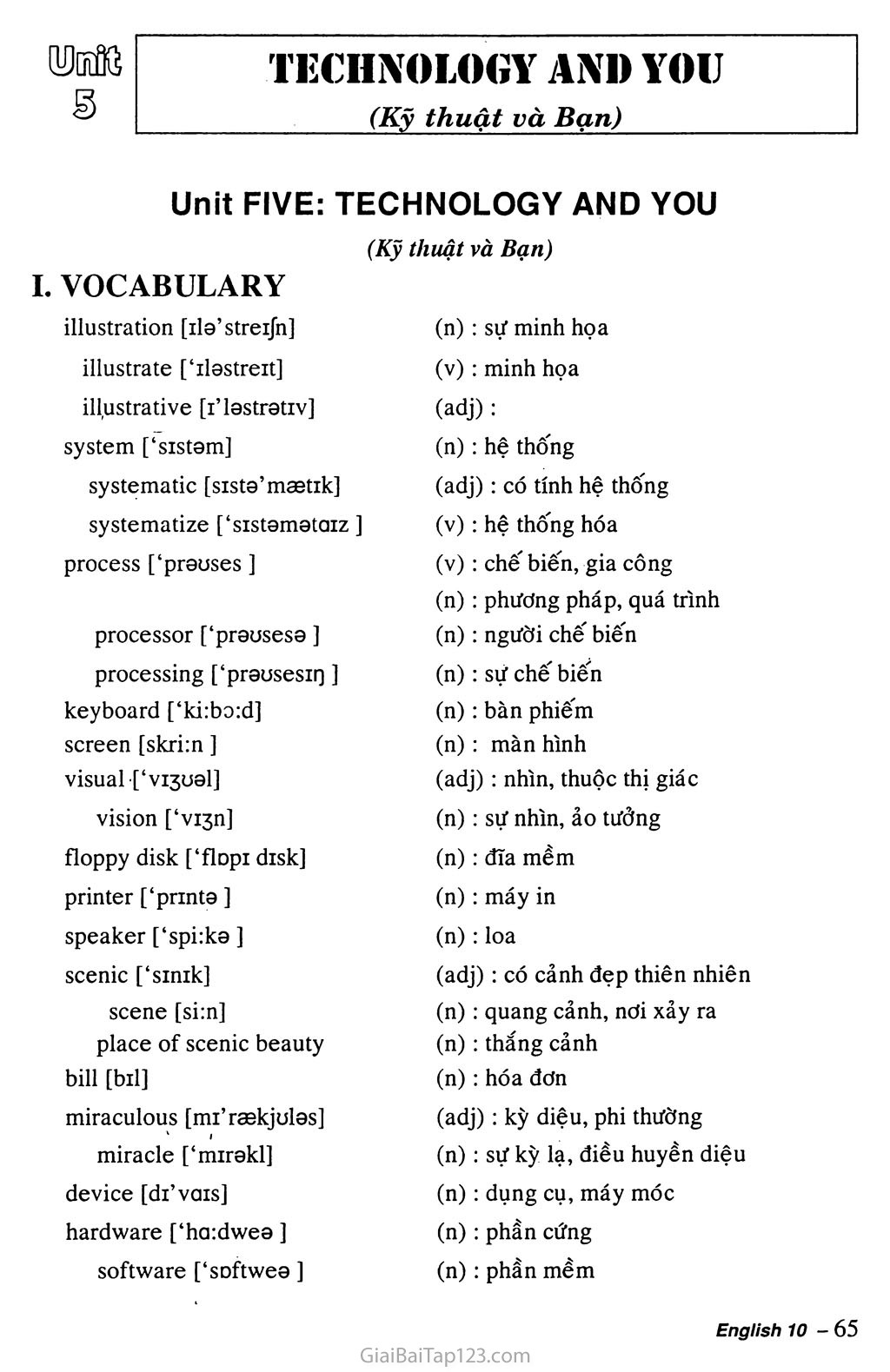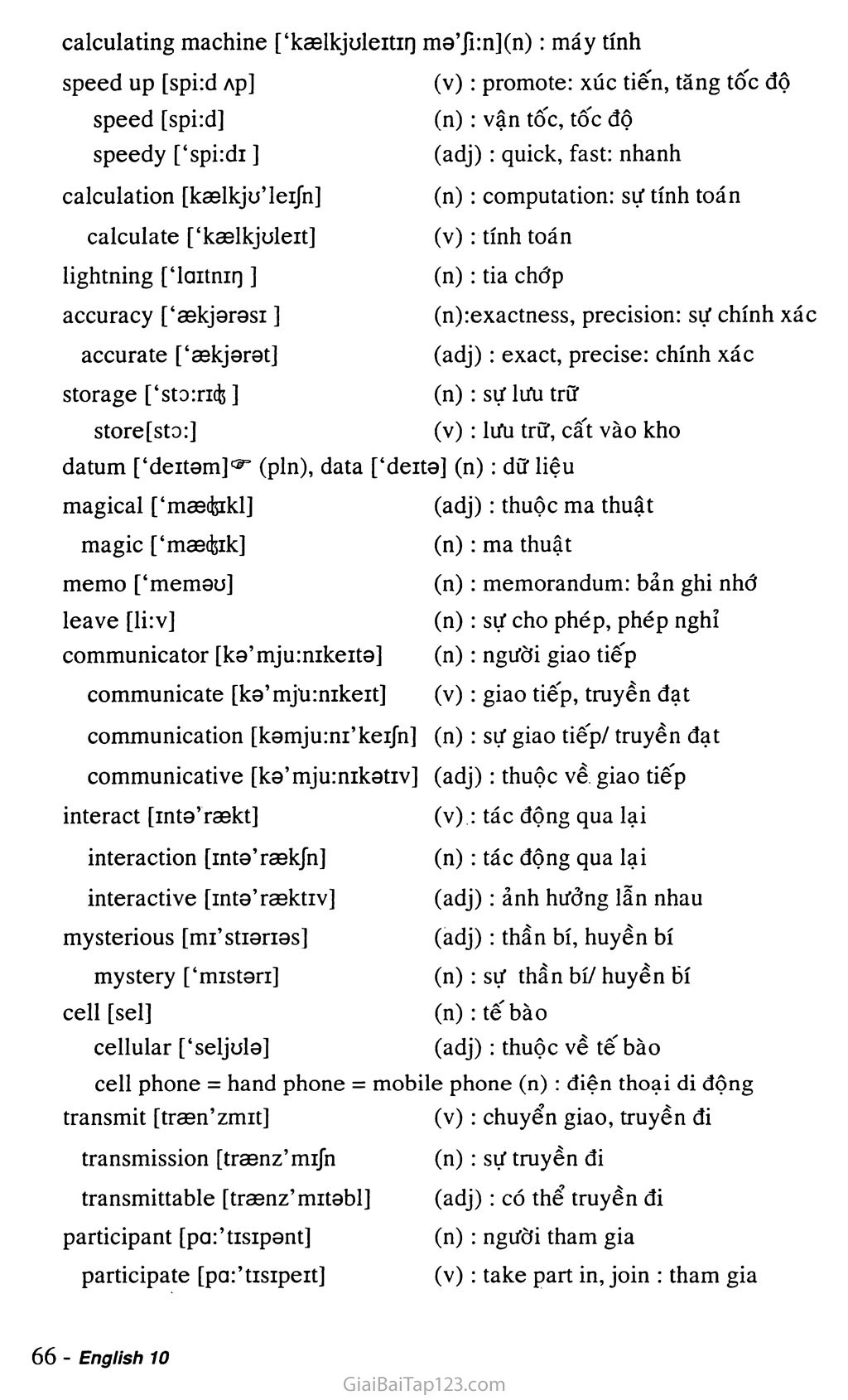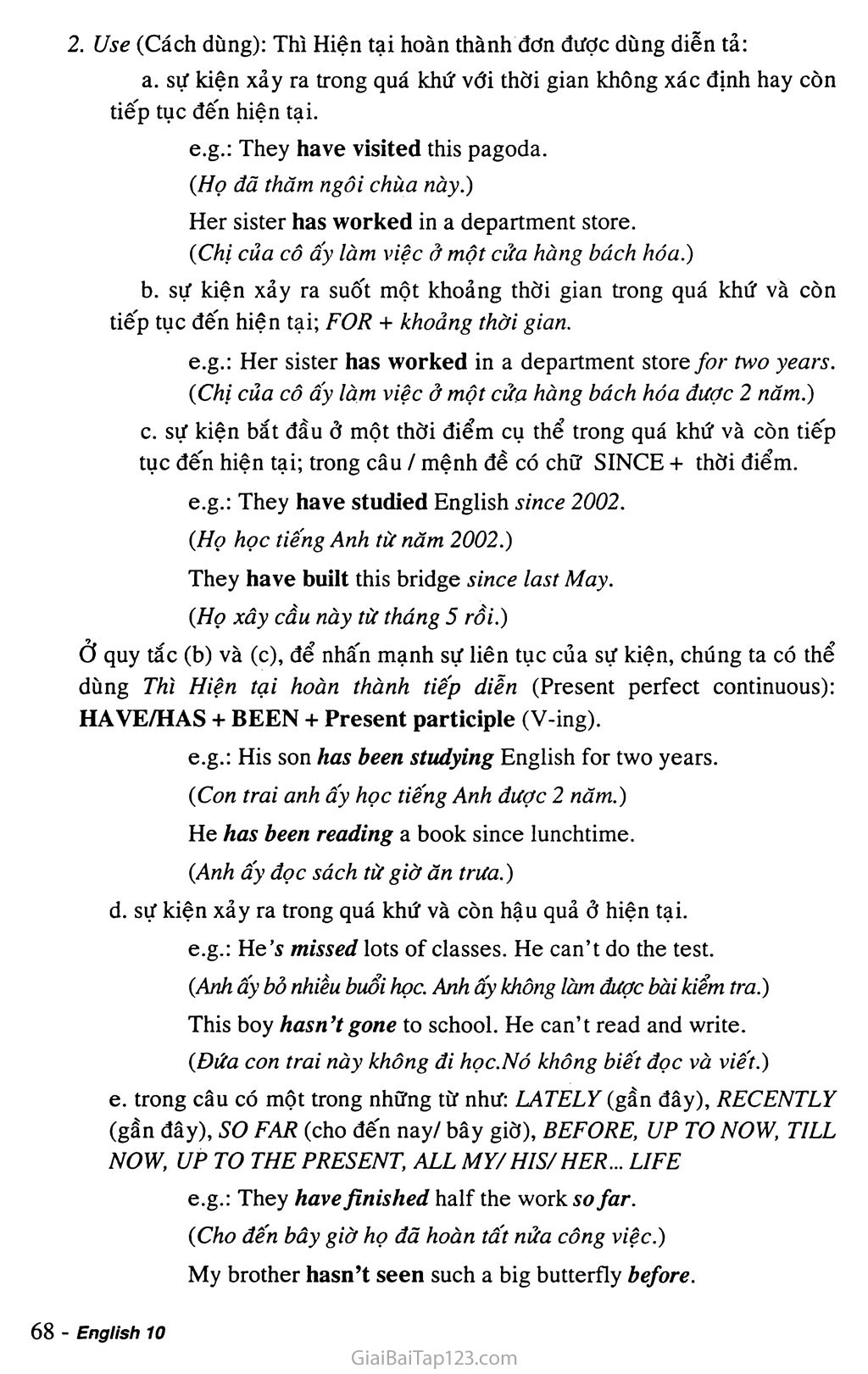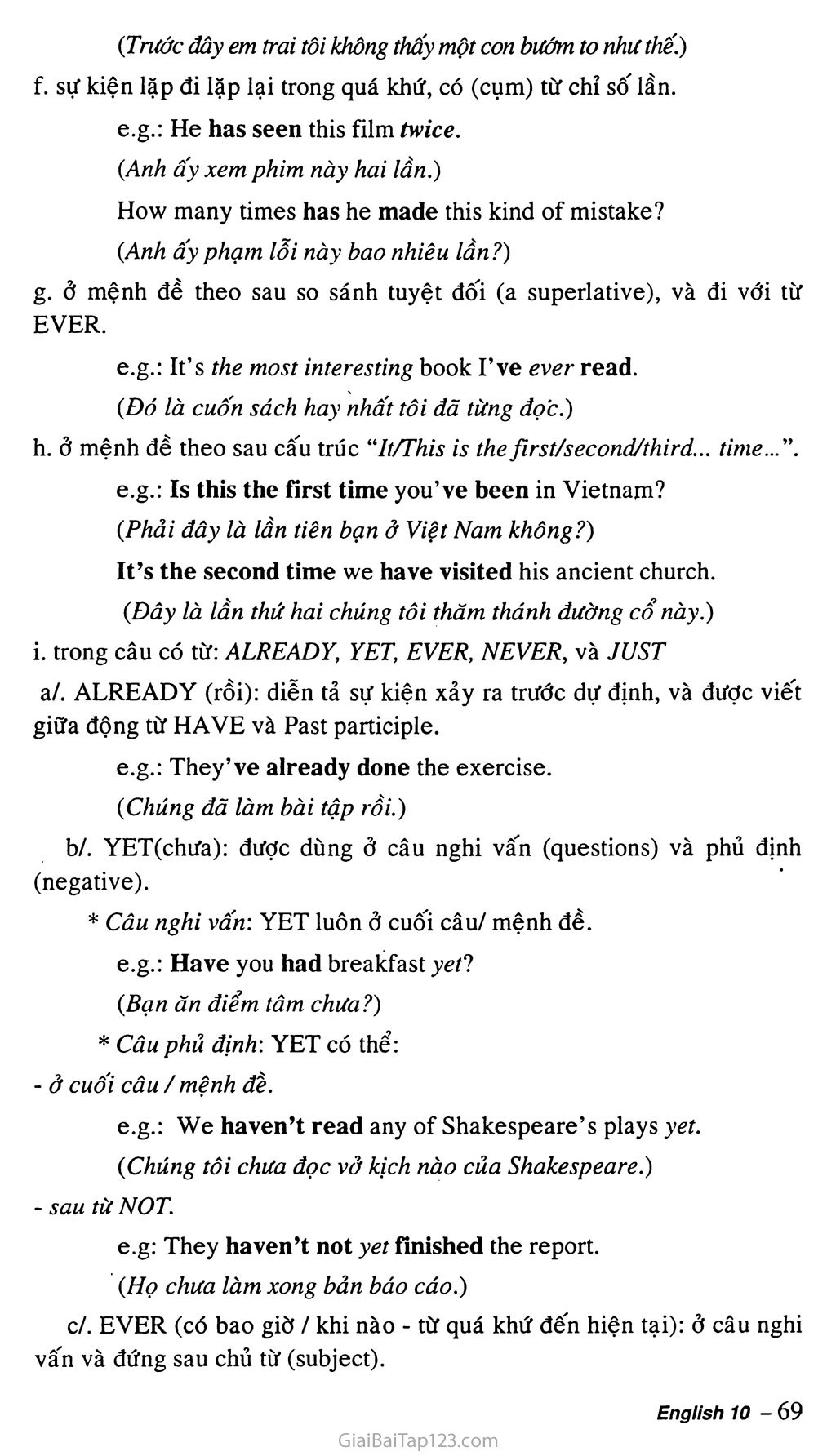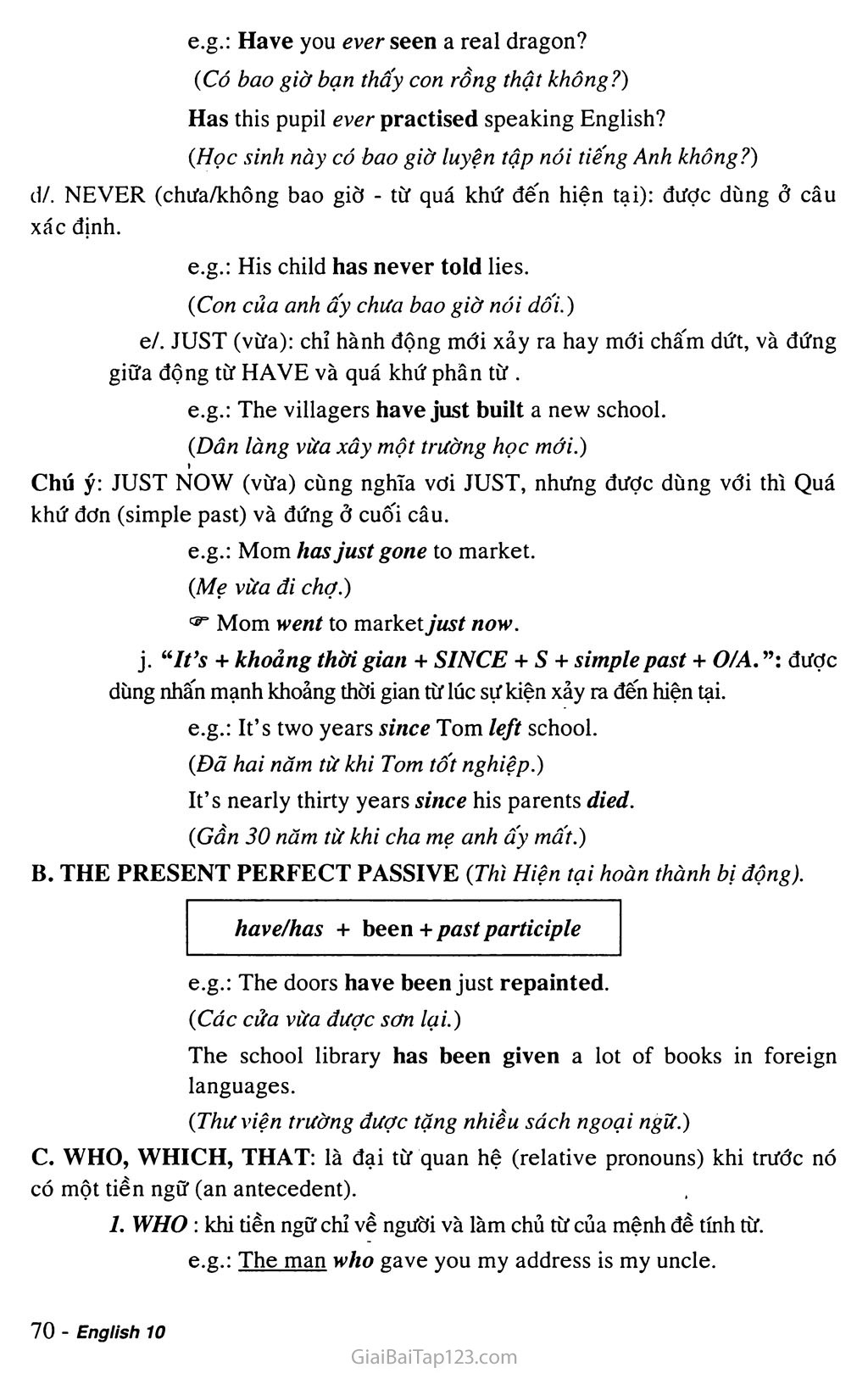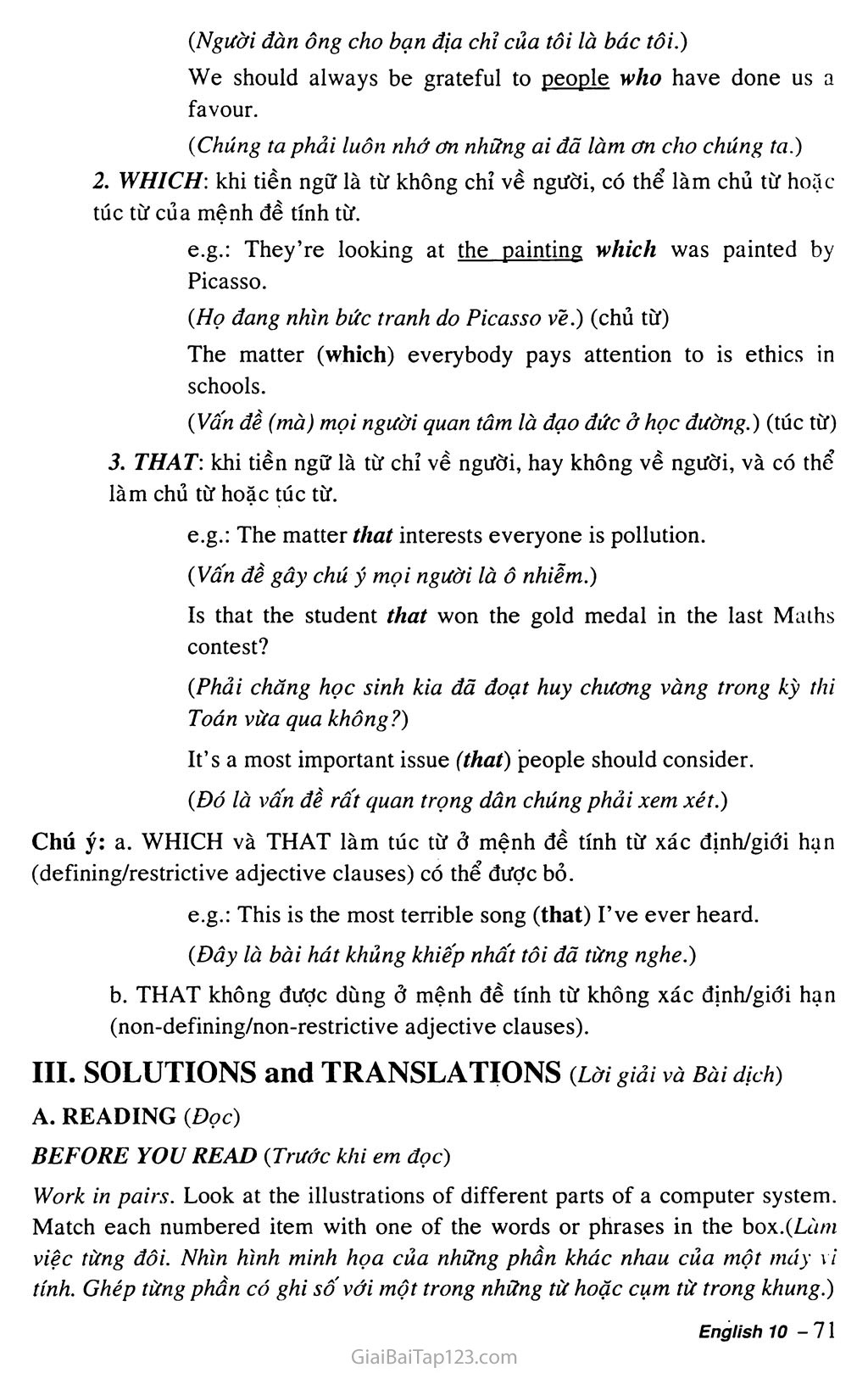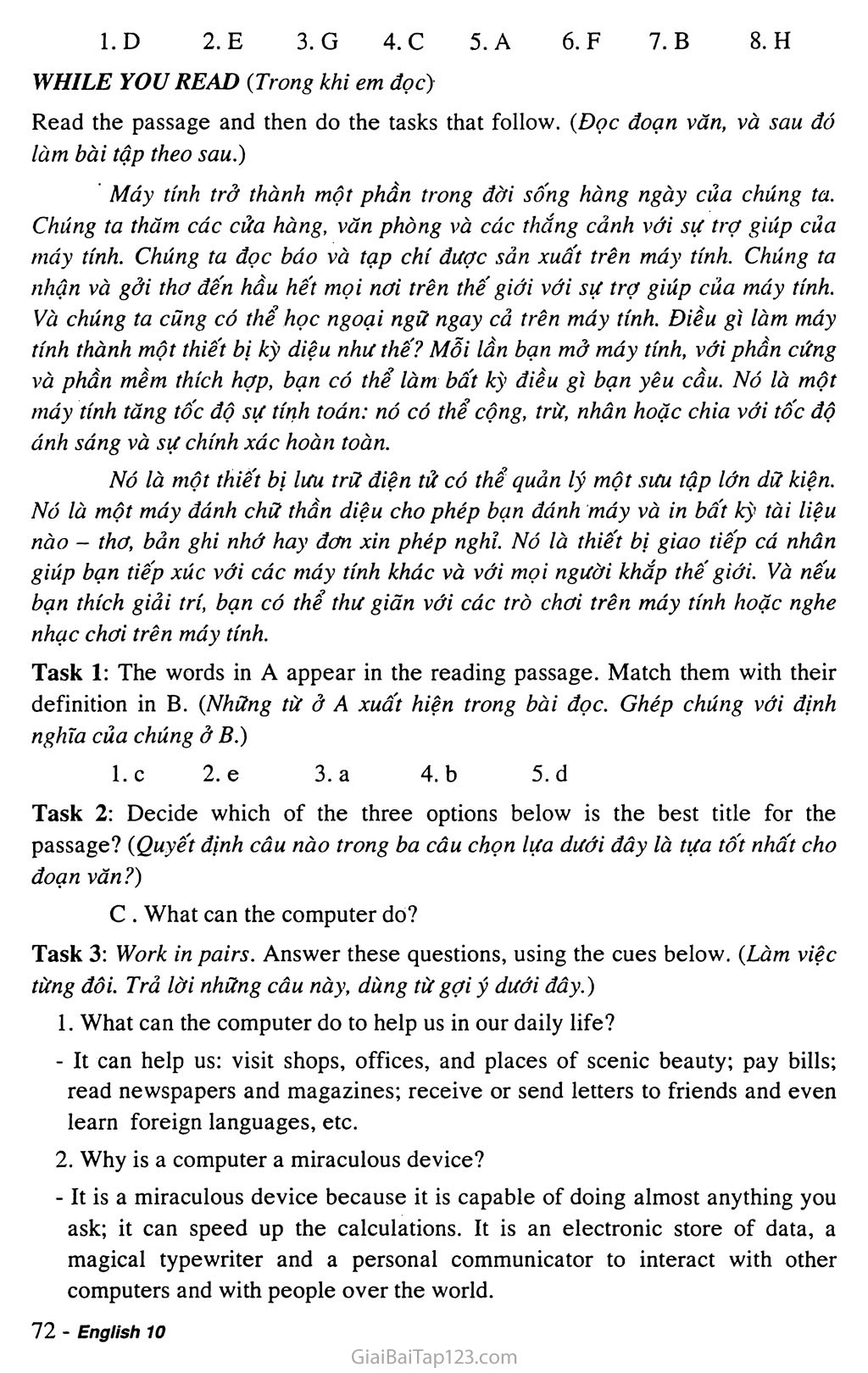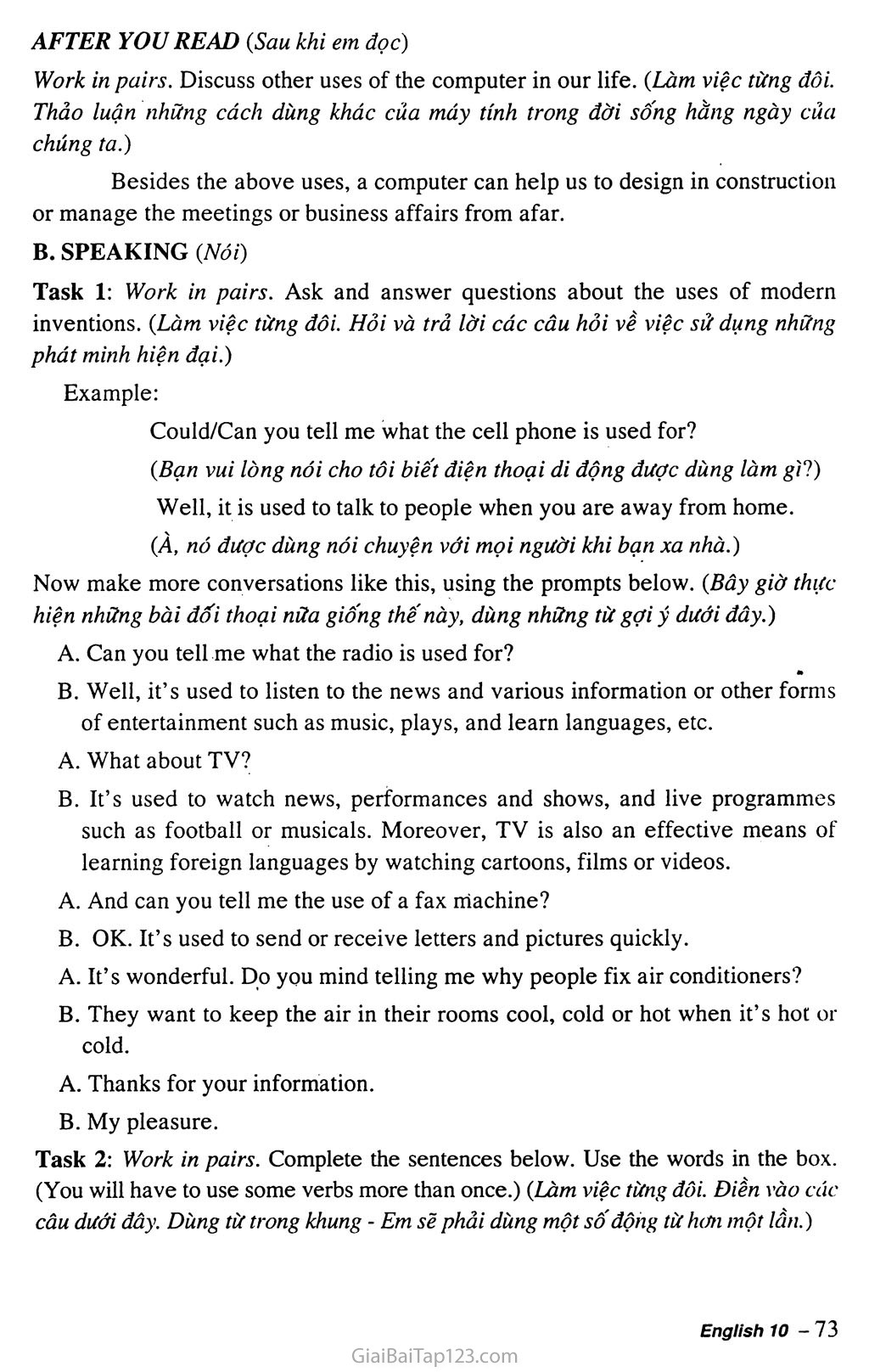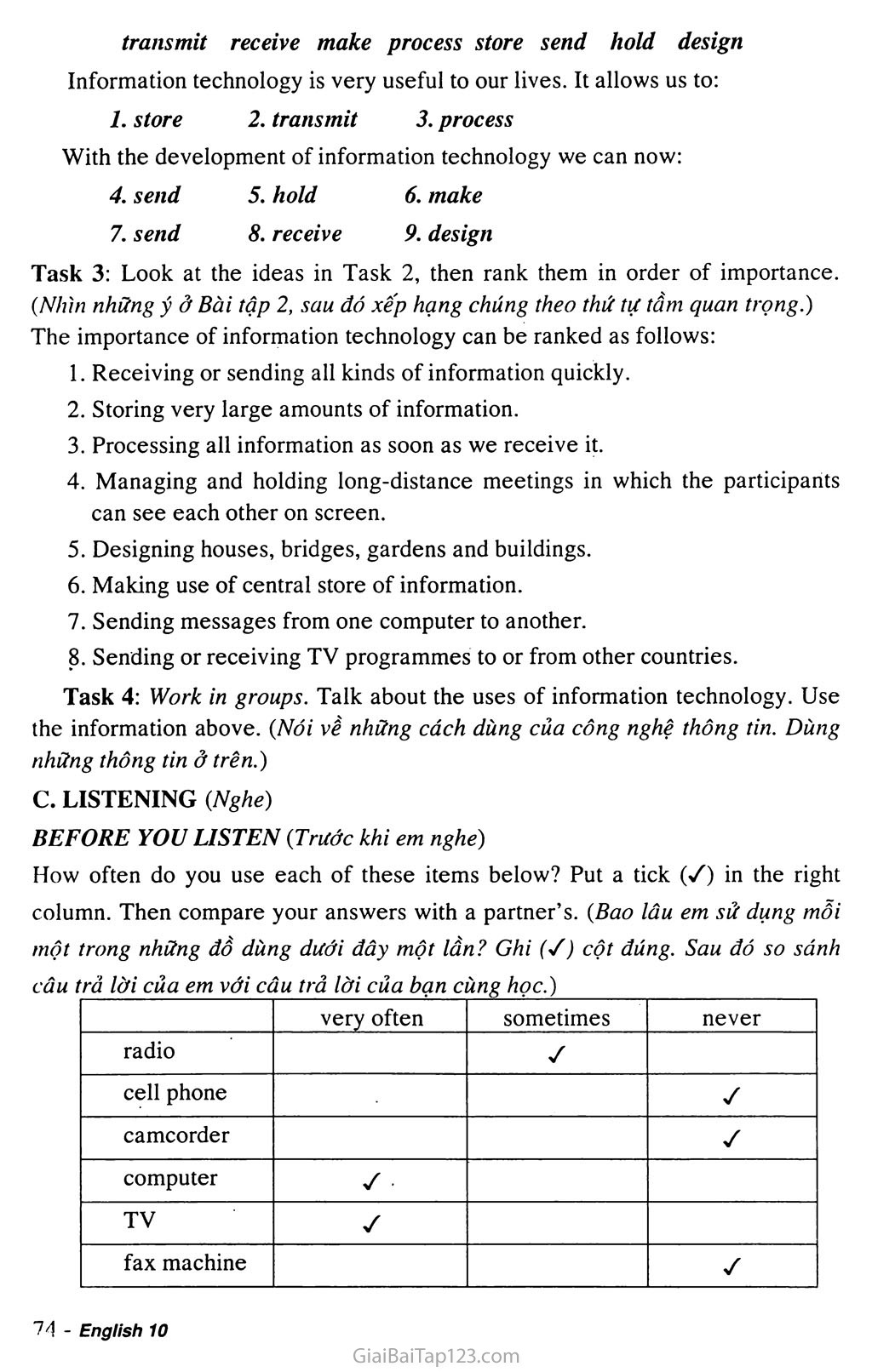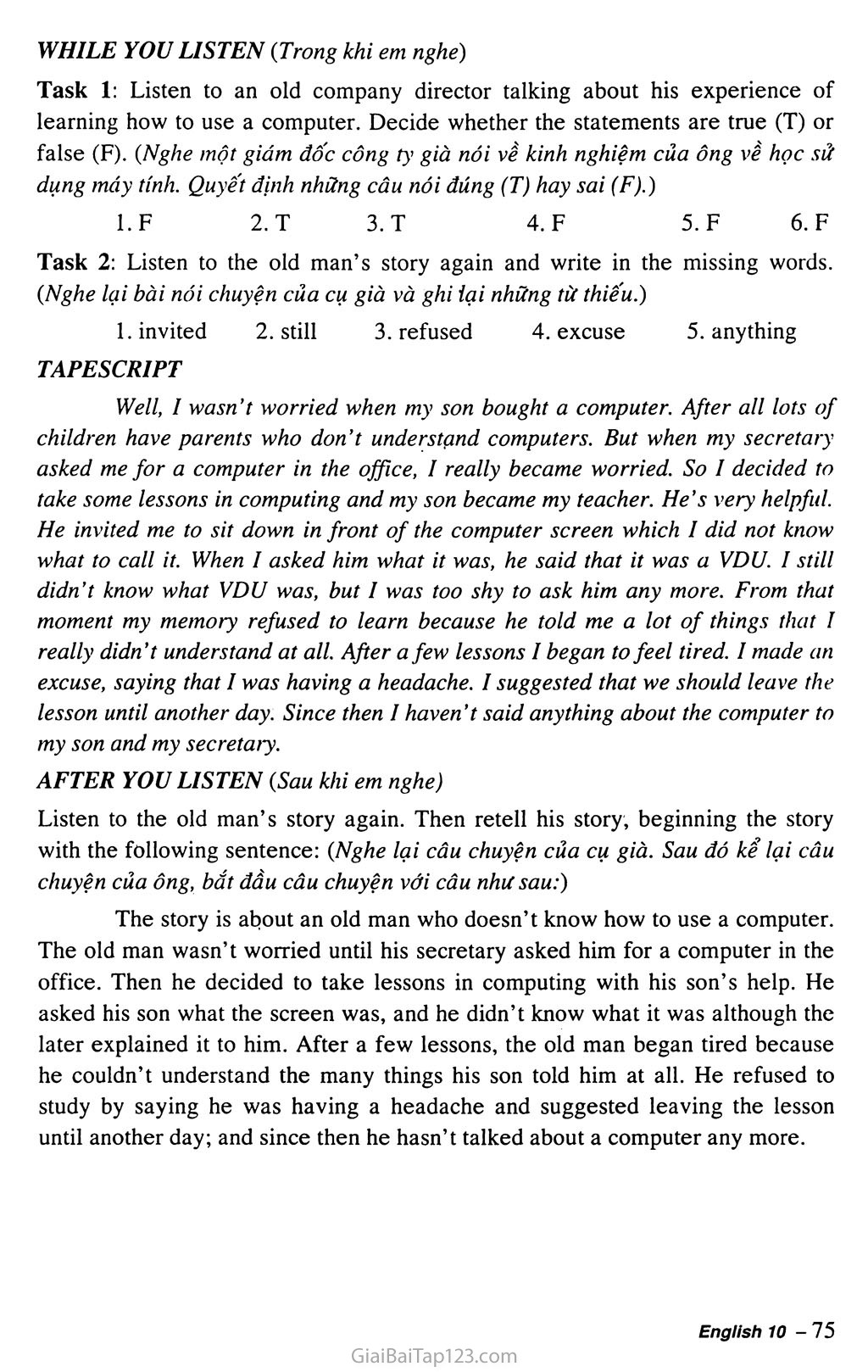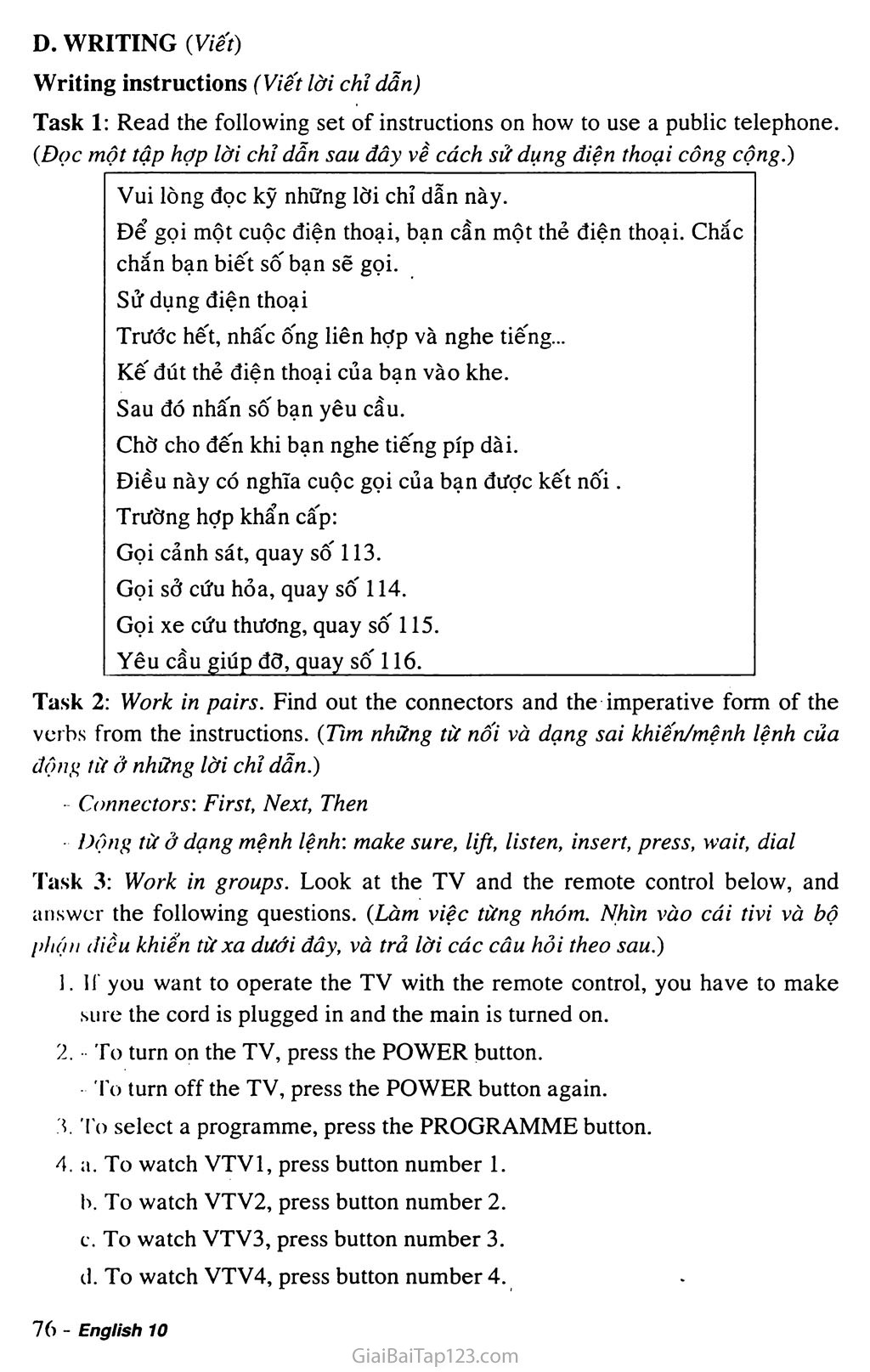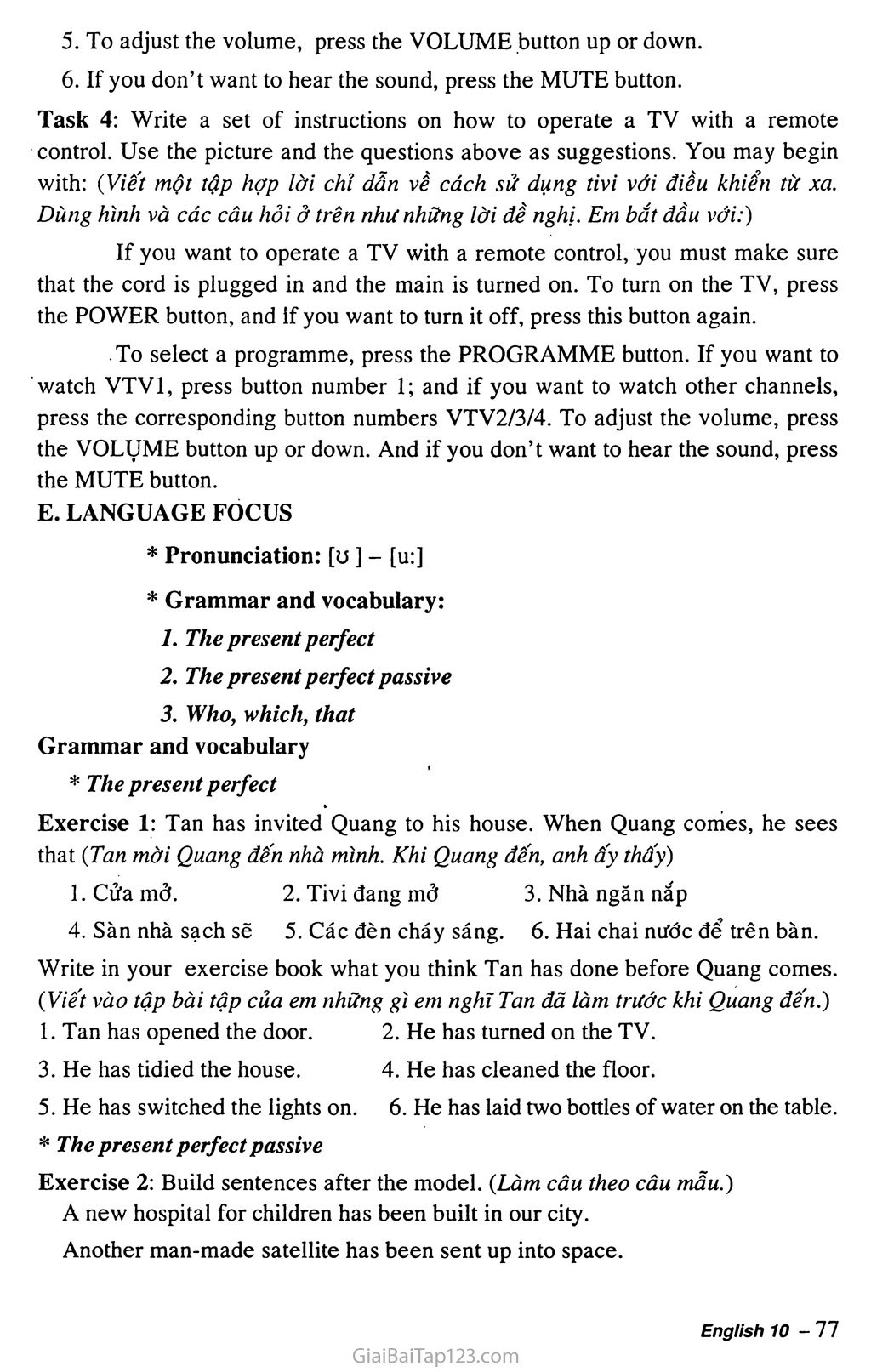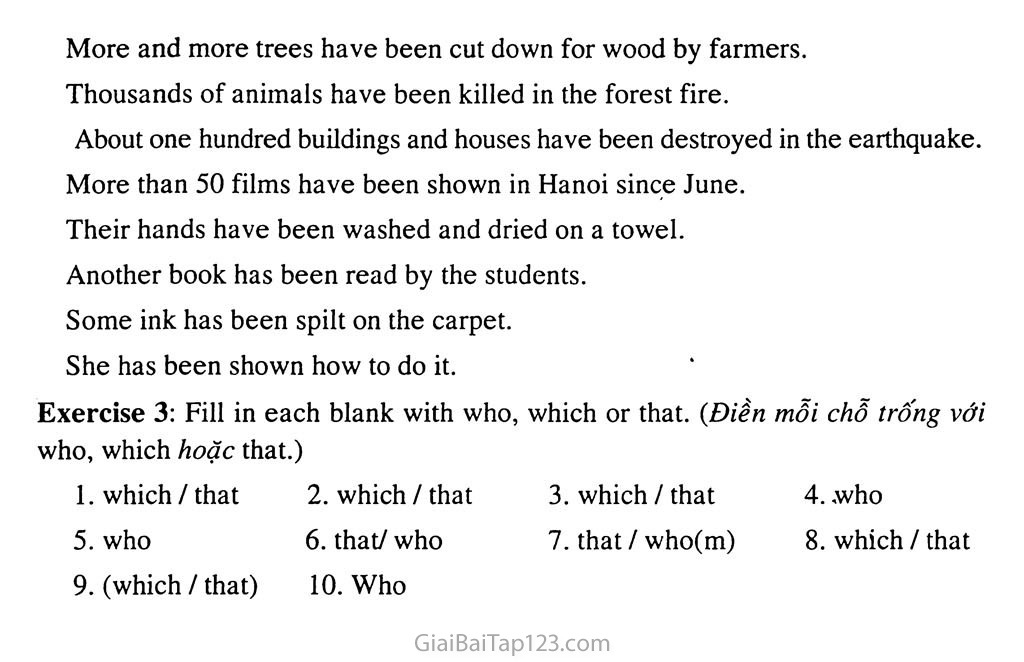Giải tiếng Anh lớp 10 Unit 5: Technology and You
CM
ể
TECHNOLOGY ANI) YOU
(Kỹ thuật và Bạn)
Unit FIVE: TECHNOLOGY AND YOU
(Kỹ thuật và Bạn)
VOCABULARY
illustration [ila’streijn]
(n) : sự minh họa
illustrate [‘ilastreit]
(v) : minh họa
illustrative [I’lastrativ]
(adj) :
system [‘sistam]
(n) : hệ thống
systematic [sista ’mastik]
(adj) : có tính hệ thống
systematize [‘sistamataiz ]
(v) : hệ thống hóa
process [‘praoses ]
(v) : chế biến, gia công (n) : phương pháp, quá trình
processor [‘praơsesa ]
(n) : người chế biến
processing [‘praơsesiq ]
(n): sự chế biến
keyboard [*ki:bo:d]
(n) : bàn phiếm
screen [skri:n ]
(n) : màn hình
visual [‘vi3ual]
(adj) : nhìn, thuộc thị giác
vision [‘vi^n]
(n) : sự nhìn, ảo tưởng
floppy disk [‘flDpi disk]
(n) : đĩa mềm
printer [‘printa ]
(n) : máy in
speaker [‘spi:ka ]
(n) : loa
scenic [‘sinik]
(adj) : có cảnh đẹp thiên nhiên
scene [si:n]
(n) : quang cảnh, nơi xảy ra
place of scenic beauty
(n) : thắng cảnh
bill [bil]
(n) : hóa đơn
miraculous [mi’rsekjulas]
(adj) : kỳ diệu, phi thường
miracle [‘mirakl]
(n) : sự kỳ lạ, điều huyền diệu
device [di’vais]
(n) : dụng cụ, máy móc
hardware [‘ha:dwea ]
(n) : phần cứng
software [‘sDftwea ]
(n) : phần mềm
calculating machine [‘kaslkjuleitiq ma’Jì:n](n): máy tính
speed up [spi:d Ap] speed [spi:d] speedy [‘spi:di ]
calculation [kaslkju’leijn] calculate [‘kaslkjuleit]
lightning [‘laitniq ] accuracy [‘aekjarasi ]
accurate [‘sekjarat] storage [‘sto:ri(fe ]
store [sto:]
(v) : promote: xúc tiến, tăng tốc độ
(n) : vận tốc, tốc độ
(adj) : quick, fast: nhanh
(n) : computation: sự tính toán
(v) : tính toán
(n) : tia chớp
(n):exactness, precision: sự chính xác (adj) : exact, precise: chính xác (n) : sự lưu trữ
datum [‘deitem]®’ (pin), data [‘delta] (n) : dữ liệu
magical [‘msedưkl]
magic [‘mascfeik]
memo [‘memau]
leave [li:v]
communicator [ka’mjumikeita] communicate [ka’mjumikeit]
(adj) : thuộc ma thuật (n) : ma thuật
(n) : memorandum: bản ghi nhớ (n) : sự cho phép, phép nghỉ (n) : người giao tiếp (v) : giao tiếp, truyền đạt
communication [ksmjumi’keijn] (n) : sự giao tiếp/ truyền đạt communicative [ka’mjumikativ] (adj) : thuộc về giao tiếp
interact [xnta’raskt]
interaction [inta’rsekjn] interactive [inta’rsektiv]
mysterious [mi’stiarias]
mystery [‘mistari]
cell [sel]
cellular [‘seljula]
(v) : tác động qua lại (n) : tác động qua lại (adj): ảnh hưởng lẫn nhau (adj) : thần bí, huyền bí (n) : sự thần bí/ huyền bí (n): tế bào
(adj) : thuộc về tế bào
cell phone = hand phone = mobile phone (n) : điện thoại di động
transmit [trasn’zmit] transmission [traenz’mifn transmittable [trasnz’mitabl]
participant [pcr’tisipont] participate [pa:’tisipeit]
(v): chuyển giao, truyền đi
(n) : sự truyền đi
(adj) : có thể truyền đi
(n): người tham gia
(v) : take part in, join : tham gia
(v) : lưu trữ, cất vào kho
participation[pa:tisi’peijn]
(n) :
sự tham gia
rank [rserjk]
(V):
xếp loại
camcorder [‘kasmko:de]
(n) :
máy quay vi-đê-ô
VDU [vi:di:’ju:]visual display unit [‘vi^uol’displei ‘ju:nit]] (n) : màn hình, thiết bị hiển thị hình ảnh
refuse [ri’fju:z]
(V)
decline : từ chòi
refusal [ri’fju:zl]
(n)
lời / sự từ chối
shy LfaiJ
(adj) : e thẹn, nhút nhát
shyness [‘/aims]
(n)
sự e thẹn
public phone = pay phone
(n)
điện thoại công cộng
make a call
(V)
gọi một cuộc gọi, gọi điện thoại
phone card [‘feon ka:d]
(n)
thẻ điện thoại
lift [lift]
(V)
nâng,nhắc
receiver [ri’skvo]
(n)
bộ phận liên hợp
dial [‘daisl]
(n)
mặt đồng hồ, bảng số
(V)
quay sô' (điện thoại)
tone [toon]
(n)
tiếng, giọng
insert [in’s3:t]
(V)
chèn vào
insertion [in’s3:Jn]
(n)
sự chèn vào
slot [slDt]
(n)
khe, kẽ
be through (to)
(V)
liên hệ (bằng điện thoại)
power [‘paoo]
(n)
electricity: điện, năng lượng
mute [mju:t]
(V)
làm câm
cord [ko:d]
(n)
sợi dây
adjust [a’cfcAst]
(V)
điều chỉnh, làm cho thích hợp
adjustment [o’tfcAstment]
(n)
sự điều chỉnh, sự chỉnh lý
adjustable [s’tfcAstsbl]
(adj) : có thể điều chỉnh
plug in 1‘plAg]
(V)
cắm (ghim) phích điện
plug
(n)
cái phích (điện), bu-gi
GRAMMAR
A. The simple present perfect tense (Thì Hiện tại hoàn thành đơn)
Form (Dạng).
has/have + past participle (P.P.)
Use (Cách dùng): Thì Hiện tại hoàn thành đơn được dùng diễn tả:
sự kiện xảy ra trong quá khứ với thời gian không xác định hay còn tiếp tục đến hiện tại.
e.g.: They have visited this pagoda.
(//ợ đã thăm ngôi chùa này.)
Her sister has worked in a department store.
(Chị của cô ấy làm việc ở một cửa hàng bách hóa.)
sự kiện xảy ra suốt một khoảng thời gian ưong quá khứ và còn tiếp tục đến hiện tại; FOR + khoảng thời gian.
e.g.: Her sister has worked in a department store for two years. {Chị của cô ấy làm việc ở một cửa hàng bách hóa được 2 năm.)
sự kiện bắt đầu ở một thời điểm cụ thể trong quá khứ và còn tiếp tục đến hiện tại; trong câu / mệnh đề có chữ SINCE + thời điểm.
e.g.: They have studied English since 2002.
{Họ học tiếng Anh từ năm 2002.)
They have built this bridge since last May.
{Họ xây cầu này từ tháng 5 rồi.)
ở quy tắc (b) và (c), để nhấn mạnh sự liên tục của sự kiện, chúng ta có thể dùng Thì Hiện tại hoàn thành tiếp diễn (Present perfect continuous): HAVE/HAS + BEEN + Present participle (V-ing).
e.g.: His son has been studying English for two years.
{Con trai anh ấy học tiếng Anh được 2 năm.)
He has been reading a book since lunchtime.
{Anh ấy đọc sách từ giờ ăn trưa.)
sự kiện xảy ra trong quá khứ và còn hậu quả ở hiện tại.
g.: He’s missed lots of classes. He can’t do the test.
{Anh ấy bỏ nhiều buổi học. Anh ấy không làm được bài kiểm tra.)
This boy hasn’t gone to school. He can’t read and write.
{Đứa con trai này không đi học.Nó không biết đọc và viết.)
trong câu có một trong những từ như: LATELY (gần đây), RECENTLY (gần đây), SO EAR (cho đến nay/ bây giờ), BEFORE, UP TO NOW, TILL NOW, UP TO THE PRESENT, ALL MY/HIS/HER... LIFE
e.g.: They have finished half the work so far.
{Cho đến bây giờ họ đã hoàn tất nửa công việc.)
My brother hasn’t seen such a big butterfly before.
{Trước đây em trai tôi không thấy một con bướm to như the.) ĩ. sự kiện lặp đi lặp lại trong quá khứ, có (cụm) từ chỉ số” lần.
e.g.: He has seen this film twice.
{Anh ấy xem phim này hai lần.)
How many times has he made this kind of mistake?
(Anh ấy phạm lỗi này bao nhiêu lần?)
ở mệnh đề theo sau so sánh tuyệt đốì (a superlative), và đi với từ EVER.
e.g.: It’s the most interesting book I’ve ever read.
{Đó là cuốn sách hay nhất tôi đã từng đọ'c.)
ở mệnh đề theo sau câ”u trúc “It/This is the first/second/third... time...".
e.g.: Is this the first time you’ve been in Vietnam?
{Phải đây là lần tiên bạn ở Việt Nam không?)
It’s the second time we have visited his ancient church.
{Đây là lần thứ hai chúng tôi thăm thánh đường cổ này.)
trong câu có từ: ALREADY, YET, EVER, NEVER, và JUST
ã/. ALREADY (rồi): diễn tả sự kiện xảy ra trước dự định, và được viết giữa động từ HAVE và Past participle.
e.g.: They’ve already done the exercise.
{Chúng đã làm bài tập rồi.)
b/. YET(chưa): được dùng ở câu nghi vấn (questions) và phủ định (negative).
* Câu nghi vấn: YET luôn ở cuối câu/ mệnh đề. e.g.: Have you had breakfast yeti {Bạn ăn điểm tâm chưa?)
* Câu phủ định: YET có thể:
ở cuối câu/mệnh đề.
e.g.: We haven’t read any of Shakespeare’s plays yet.
{Chúng tôi chưa đọc vở kịch nào của Shakespeare.)
sau từ NOT.
e.g: They haven’t not yet finished the report.
{Họ chưa làm xong bản báo cáo.)
c/. EVER (có bao giờ / khi nào - từ quá khứ đến hiện tại): ở câu nghi vấn và đứng sau chủ từ (subject).
e.g.: Have you ever seen a real dragon?
(Cớ bao giờ bạn thấy con rồng thật không?')
Has this pupil ever practised speaking English?
{Học sinh này có bao giờ luyện tập nói tiếng Anh không?} d/. NEVER (chưa/không bao giờ - từ quá khứ đến hiện tại): được dùng ở câu xác định.
e.g.: His child has never told lies.
{Con của anh ấy chưa bao giờ nói dôi.} e/. JUST (vừa): chỉ hành động mới xảy ra hay mới chẩm dứt, và đứng
giữa động từ HAVE và quá khứ phân từ .
e.g.: The villagers have just built a new school.
{Dân làng vừa xây một trường học mới.}
Chú ý: JUST NOW (vừa) cùng nghĩa vơi JUST, nhưng được dùng với thì Quá khứ đơn (simple past) và đứng ở cuối câu.
e.g.: Mom has just gone to market.
{Mẹ vừa đi chợ.}
Mom went to market just now.
“/z’s + khoảng thời gian + SINCE + s + simple past + O/A. được dùng nhấn mạnh khoảng thời gian từ lúc sự kiện xảy ra đến hiện tại. e.g.: It’s two years since Tom left school.
{Đã hai năm từ khi Tom tốt nghiệp.}
It’s nearly thirty years since his parents died.
{Gần 30 năm từ khi cha mẹ anh ấy mất.}
B. THE PRESENT PERFECT PASSIVE (77zỉ Hiện tại hoàn thành bị động), have/has + been + past participle
e.g.: The doors have been just repainted.
{Các cửa vừa được sơn lại.)
The school library has been given a lot of books in foreign languages.
{Thư viện trường được tặng nhiều sách ngoại ngữ.) c. WHO, WHICH, THAT: là đại từ quan hệ (relative pronouns) khi trước nó có một tiền ngữ (an antecedent).
WHO : khi tiền ngữ chỉ về người và làm chủ từ của mệnh đề tính từ. e.g.: The man who gave you my address is my uncle.
{Người đàn ông cho bạn địa chỉ của tôi là bác tôi.')
We should always be grateful to people who have done US a favour.
{Chúng ta phải luôn nhớ ơn những ai đã làm ơn cho chúng ta.)
WHICH-, khi tiền ngữ là từ không chỉ về người, có thể làm chủ từ hoặc túc từ của mệnh đề tính từ.
e.g.: They’re looking at the painting which was painted by
Picasso.
{Họ đang nhìn bức tranh do Picasso vẽ.) (chủ từ)
The matter (which) everybody pays attention to is ethics in schools.
{Vấn đề (mà) mọi người quan tâm là đạo đức ở học đường.) (túc từ)
THAT-, khi tiền ngữ là từ chỉ về người, hay không về người, và có thể làm chủ từ hoặc túc từ.
e.g.: The matter that interests everyone is pollution.
(Vấn đề gây chú ý mọi người là ô nhiễm.)
Is that the student that won the gold medal in the last Maths contest?
(Phải chăng học sinh kia đã đoạt huy chương vàng trong kỳ thi
Toán vừa qua không ?)
It’s a most important issue (that) people should consider.
(Đó là vấn đề rất quan trọng dân chúng phải xem xét.)
Chú ý: a. WHICH và THAT làm túc từ ở mệnh đề tính từ xác định/giới hạn (defining/restrictive adjective clauses) có thể được bỏ.
e.g.: This is the most terrible song (that) I’ve ever heard.
(Đây là bài hát khủng khiếp nhất tôi đã từng nghe.)
b. THAT không được dùng ở mệnh đề tính từ không xác định/giới hạn (non-defining/non-restrictive adjective clauses).
III. SOLUTIONS and TRANSLATIONS (Lời giải và Bùi dịch)
A. READING (Đọc)
BEFORE YOU READ (Trước khi em đọc)
Work in pairs. Look at the illustrations of different parts of a computer system. Match each numbered item with one of the words or phrases in the box.(Lùm việc từng đôi. Nhìn hình minh họa của những phần khác nhau của một máy vi tính. Ghép từng phần có ghi số với một trong những từ hoặc cụm từ trong khung.)
3. G 4.C 5. A 6.F 7. B
8. H
D 2. E WHILE YOU READ (Trong khi em đọc)
Read the passage and then do the tasks that follow. (Đọc đoạn văn, và sau đó làm bài tập theo sau.)
Máy tính trở thành một phần trong đời sống hàng ngày của chúng ta. Chúng ta thăm các cửa hàng, văn phòng và cúc thắng cảnh với sự trợ giúp của máy tính. Chúng ta đọc báo và tạp chí được sản xuất trên máy tính. Chúng ta nhận và gởi thơ đến hầu hết mọi nơi trên thế giới với sự trợ giúp của máy tính. Và chúng ta cũng có thể học ngoại ngữ ngay cả trên máy tính. Điều gì làm máy tính thành một thiết bị kỳ diệu như thế? Mỗi lần bạn mở máy tính, với phần cứng và phần mềm thích hợp, bạn có thể làm bất kỳ điều gì bạn yêu cầu. Nó là một máy tính tăng tốc độ sự tính toán: nó có thể cộng, trừ, nhân hoặc chia với tốc độ ánh sáng và sự chính xác hoàn toàn.
Nó là một thiết bị lưu trữ điện tử có thể quản lý một sưu tập lớn dữ kiện. Nó là một máy đánh chữ thần diệu cho phép bạn đánh máy và in bất kỳ tài liệu nào - thơ, bản ghi nhớ hay đơn xin phép nghỉ. Nó là thiết bị giao tiếp cá nhân giúp bạn tiếp xúc với các máy tính khác và với mọi người khắp thế giới. Và nếu bạn thích giải trí, bạn có thể thư giãn với các trò chơi trên máy tính hoặc nghe nhạc chơi trên máy tính.
Task 1: The words in A appear in the reading passage. Match them with their definition in B. (Những từ Ở A xuất hiện trong bài dọc. Ghép chúng với định nghĩa của chúng ở B.)
1. c 2. e 3. a 4. b 5. d
Task 2: Decide which of the three options below is the best title for the passage? (Quyết định câu nào trong ba câu chọn lựa dưới đây là tựa tốt nhất cho đoạn văn?)
c . What can the computer do?
Task 3: Work in pairs. Answer these questions, using the cues below. (Làm việc từng dôi. Trả lời những câu này, dùng từ gợi ý dưới đây.)
What can the computer do to help US in our daily life?
It can help us: visit shops, offices, and places of scenic beauty; pay bills; read newspapers and magazines; receive or send letters to friends and even learn foreign languages, etc.
Why is a computer a miraculous device?
It is a miraculous device because it is capable of doing almost anything you ask; it can speed up the calculations. It is an electronic store of data, a magical typewriter and a personal communicator to interact with other computers and with people over the world.
AFTER YOU READ {Sau khi em đọc)
Work in pairs. Discuss other uses of the computer in our life. {Làm việc từng đôi. Thảo luận những cách dùng khác của máy tính trong đời sống hằng ngày của chúng ta.)
Besides the above uses, a computer can help US to design in construction or manage the meetings or business affairs from afar.
B. SPEAKING {Nói)
Task 1: Work in pairs. Ask and answer questions about the uses of modern inventions. {Làm việc từng đôi. Hỏi và trả lời các câu hỏi về việc sử dụng những phát minh hiện đại.)
Example:
Could/Can you tell me what the cell phone is used for?
{Bạn vui lòng nói cho tôi biết điện thoại di dộng được dùng làm gì?) Well, it is used to talk to people when you are away from home.
(À, nó được dùng nói chuyện với mọi người khi bạn xa nhà.)
Now make more conversations like this, using the prompts below. {Bây giờ thực hiện những bài đối thoại nữa giống thế này, dùng những từ gợi ý dưới đây.)
Can you tell me what the radio is used for?
Well, it’s used to listen to the news and various information or other forms of entertainment such as music, plays, and learn languages, etc.
What about TV?
It’s used to watch news, performances and shows, and live programmes such as football or musicals. Moreover, TV is also an effective means of learning foreign languages by watching cartoons, films or videos.
And can you tell me the use of a fax machine?
OK. It’s used to send or receive letters and pictures quickly.
It’s wonderful. Do you mind telling me why people fix air conditioners?
They want to keep the air in their rooms cool, cold or hot when it’s hot or cold.
Thanks for your information.
My pleasure.
Task 2: Work in pairs. Complete the sentences below. Use the words in the box. (You will have to use some verbs more than once.) {Làm việc từng đôi. Điền vào cúc câu dưới đây. Dùng từ trong khung - Em sẽ phải dùng một số dộng từ hơn một lần.)
transmit receive make process store send hold design
Information technology is very useful to our lives. It allows US to:
store 2. transmit 3. process
With the development of information technology we can now:
send 5. hold 6. make
send 8. receive 9. design
Task 3: Look at the ideas in Task 2, then rank them in order of importance. (Nhìn những ý ở Bài tập 2, sau đỏ xếp hạng chúng theo thứ tự tầm quan trọng.) The importance of information technology can be ranked as follows:
Receiving or sending all kinds of information quickly.
Storing very large amounts of information.
Processing all information as soon as we receive it.
Managing and holding long-distance meetings in which the participants can see each other on screen.
Designing houses, bridges, gardens and buildings.
Making use of central store of information.
Sending messages from one computer to another.
Sending or receiving TV programmes to or from other countries.
Task 4: Work in groups. Talk about the uses of information technology. Use the information above. (Nói về những cách dùng của công nghệ thông tin. Dùng những thông tin ở trên.)
c. LISTENING (Nghe)
BEFORE YOU LISTEN (Trước khi em nghe)
How often do you use each of these items below? Put a tick (Z) in the right column. Then compare your answers with a partner’s. (Bao lâu em sử dụng mỗi một trong những đồ dùng dưới đây một lần? Ghi (V) cột đúng. Sau đó so sánh câu trả lời của em với câu trả lời của bạn cùng học.)
very often
sometimes
never
radio
z
cell phone
z
camcorder
z
computer
z
TV
z
fax machine
z
WHILE YOU LISTEN (Trong khi em nghe)
Task 1: Listen to an old company director talking about his experience of learning how to use a computer. Decide whether the statements are true (T) or false (F). (Nghe một giám đốc công ty già nói về kinh nghiệm của ông về học sử dụng máy tính. Quyết định những câu nói đúng (T) hay sai (F).)
1.F 2. T 3. T 4.F 5. F 6. F
Task 2: Listen to the old man’s story again and write in the missing words. (Nghe lại bài nói chuyện của cụ già và ghi iại những từ thiếu.)
1. invited 2. still 3. refused 4. excuse 5. anything TAPESCRIPT
Well, I wasn’t worried when my son bought a computer. After all lots of children have parents who don’t understand computers. But when my secretary asked me for a computer in the office, I really became worried. So I decided to take some lessons in computing and my son became my teacher. He’s very helpful. He invited me to sit down in front of the computer screen which I did not know what to call it. When I asked him what it was, he said that it was a VDU. I still didn’t know what VDU was, but I was too shy to ask him any more. From that moment my memory refused to learn because he told me a lot of things that I really didn’t understand at all. After a few lessons I began to feel tired. I made an excuse, saying that I was having a headache. I suggested that we should leave the lesson until another day. Since then I haven’t said anything about the computer to my son and my secretary.
AFTER YOU LISTEN (Sau khi em nghe)
Listen to the old man’s story again. Then retell his story, beginning the story with the following sentence: (Nghe lại câu chuyện của cụ già. Sau đó kể lại câu chuyện của ông, bắt đầu câu chuyện với câu như sau:)
The story is about an old man who doesn’t know how to use a computer. The old man wasn’t worried until his secretary asked him for a computer in the office. Then he decided to take lessons in computing with his son’s help. He asked his son what the screen was, and he didn’t know what it was although the later explained it to him. After a few lessons, the old man began tired because he couldn’t understand the many things his son told him at all. He refused to study by saying he was having a headache and suggested leaving the lesson until another day; and since then he hasn’t talked about a computer any more.
D. WRITING (Viết)
Writing instructions (Viết lời chỉ dẫn)
Task 1: Read the following set of instructions on how to use a public telephone. (Đọc một tập hợp lời chỉ dẫn sau dây về cách sử dụng điện thoại công cộng.)
Vui lòng đọc kỹ những lời chỉ dẫn này.
Đê’ gọi một cuộc điện thoại, bạn cần một thẻ điện thoại. Chắc chắn bạn biết sô" bạn sẽ gọi.
Sử dụng điện thoại
Trước hết, nhác ống liên hợp và nghe tiếng...
Kế đút thẻ điện thoại của bạn vào khe.
Sau đó nhân số bạn yêu cầu.
Chờ cho đến khi bạn nghe tiếng píp dài.
Điều này có nghĩa cuộc gọi của bạn được kết nô"i.
Trường hợp khẩn cấp:
Gọi cảnh sát, quay số 113.
Gọi sở cứu hỏa, quay số 114.
Gọi xe cứu thương, quay sô" 115.
Yêu cầu giúp đỡ, quay sô" 116.
Task 2: Work in pairs. Find out the connectors and the imperative form of the verbs from the instructions. (Tìm những từ nối và dạng sai khiến/mệnh lệnh của động từ ở những lời chỉ dẫn.)
- Connectors'. First, Next, Then
Dộng từ ở dạng mệnh lệnh', make sure, lift, listen, insert, press, 'wait, dial
Task 3: Work in groups. Look at the TV and the remote control below, and answer the following questions. (Làm việc từng nhóm. Nhìn vào cái tivi và bộ phận diều khiên từ xa dưới dây, và trả lời các câu hỏi theo sau.)
If you want to operate the TV with the remote control, you have to make sure the cord is plugged in and the main is turned on.
To turn on the TV, press the POWER button.
To turn off the TV, press the POWER button again.
To select a programme, press the PROGRAMME button.
a. To watch VTV1, press button number 1.
To watch VTV2, press button number 2.
To watch VTV3, press button number 3.
To watch VTV4, press button number 4.
To adjust the volume, press the VOLUME button up or down.
If you don’t want to hear the sound, press the MUTE button.
Task 4: Write a set of instructions on how to operate a TV with a remote control. Use the picture and the questions above as suggestions. You may begin with: {Viết một tập hợp lời chỉ dẫn về cách sử dụng tỉvi với điều khiển từ xa. Dùng hình và các câu hỏi ở trên như những lời đề nghị. Em bắt đầu với:)
If you want to operate a TV with a remote control, you must make sure that the cord is plugged in and the main is turned on. To turn on the TV, press the POWER button, and If you want to turn it off, press this button again.
To select a programme, press the PROGRAMME button. If you want to watch VTV1, press button number 1; and if you want to watch other channels, press the corresponding button numbers VTV2/3/4. To adjust the volume, press the VOLUME button up or down. And if you don’t want to hear the sound, press the MUTE button.
E. LANGUAGE FOCUS
Pronunciation: [Ơ ] - [u:]
Grammar and vocabulary:
The present perfect
The present perfect passive
Who, which, that Grammar and vocabulary
* The present perfect
Exercise 1: Tan has invited Quang to his house. When Quang comes, he sees that {Tan mời Quang đến nhà mình. Khi Quang đến, anh ấy thấy')
1. Cửa mở. 2. Tivi đang mở 3. Nhà ngăn nắp
Sàn nhà sạch sẽ 5. Các đèn cháy sáng. 6. Hai chai nước để trên bàn.
Write in your exercise book what you think Tan has done before Quang comes. (Viết vào tập bài tập của em những gì em nghĩ Tan ãã làm trước khi Quang đến.) 1. Tan has opened the door. 2. He has turned on the TV.
He has tidied the house. 4. He has cleaned the floor.
He has switched the lights on. 6. He has laid two bottles of water on the table. * The present perfect passive
Exercise 2: Build sentences after the model. {Làm câu theo câu mẫu.)
A new hospital for children has been built in our city.
Another man-made satellite has been sent up into space.
More and more trees have been cut down for wood by farmers.
Thousands of animals have been killed in the forest fire.
About one hundred buildings and houses have been destroyed in the earthquake.
More than 50 films have been shown in Hanoi since June.
' «
Their hands have been washed and dried on a towel.
Another book has been read by the students.
Some ink has been spilt on the carpet.
She has been shown how to do it.
Exercise 3: Fill in each blank with who, which or that. {Điền mỗi chỗ trống với who, which hoặc that.)
1. which / that 2. which / that 3. which I that 4. who
who 6. that/ who 7. that / who(m) 8. which / that
(which / that) 10. Who

